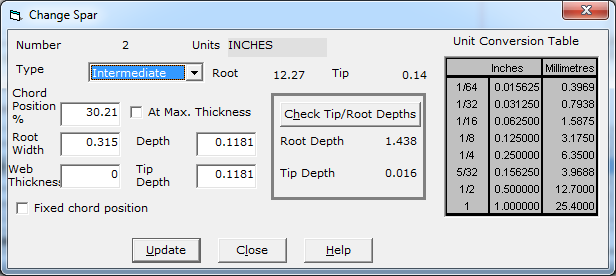SPAR DETAIL DESIGN SCREEN
Detailed ExampleSpar_Design_Example
 This screen is used to specify the spar and shear web details. The items on this screen are as follows;
This screen is used to specify the spar and shear web details. The items on this screen are as follows;
 Number is automatically assigned by WINFOIL when a spar is created.
Number is automatically assigned by WINFOIL when a spar is created.
 Units default to the units selected for the wing or tail design.
Units default to the units selected for the wing or tail design.
 Type is the type of spar. This can be either of the following; leading edge, trailing edge or intermediate.
Type is the type of spar. This can be either of the following; leading edge, trailing edge or intermediate.
 Root and Tip are the Root and Tip chord lengths respectively. These are expressed in the dimensional units selected for the wing or tail design.
Root and Tip are the Root and Tip chord lengths respectively. These are expressed in the dimensional units selected for the wing or tail design.
 Chord Position % is the location of the spar as a percentage of the root chord.
Chord Position % is the location of the spar as a percentage of the root chord.
 At Max. Thickness places the spar location at the position of maximum thickness based on the root airfoil selected. Click on this to position at this point. From a structural viewpoint the maximum thickness point is the ideal placement for an intermediate spar as spar strength is proportional to the vertical depth. The greater the depth the greater the bending strength.
At Max. Thickness places the spar location at the position of maximum thickness based on the root airfoil selected. Click on this to position at this point. From a structural viewpoint the maximum thickness point is the ideal placement for an intermediate spar as spar strength is proportional to the vertical depth. The greater the depth the greater the bending strength.
 Check Root/Tip Depths button. Click on this button to determine the depth at the root and tip at the chord position selected. If the depth of the spar exceeds these measurements then the spar depth will default to full depth.
Check Root/Tip Depths button. Click on this button to determine the depth at the root and tip at the chord position selected. If the depth of the spar exceeds these measurements then the spar depth will default to full depth.
 Root Width is the width of the spar in units defined by the wing or tail design.
Root Width is the width of the spar in units defined by the wing or tail design.
 Depth is the depth of the spar at the root. Leading and trailing edge spars default to a depth of zero as these are full depth.
Depth is the depth of the spar at the root. Leading and trailing edge spars default to a depth of zero as these are full depth.
 Web thickness is the thickness of the shear web. Intermediate spars have two shear webs. One on each facing side of the spar. Leading and trailing edge spars can only have one web on the inboard side of the spar. The units for the shear web are the same as for the wing or tail design.
Web thickness is the thickness of the shear web. Intermediate spars have two shear webs. One on each facing side of the spar. Leading and trailing edge spars can only have one web on the inboard side of the spar. The units for the shear web are the same as for the wing or tail design.
 Tip Depth is the depth of the spar at the tip. This is in the same units selected for the wing or tail design.
Tip Depth is the depth of the spar at the tip. This is in the same units selected for the wing or tail design.
Fixed chord position
Select this option to fix the spar position to a selected chord location at the root rib.
If this option is not selected the spar will be located at the entered chord position along the span of the wing.
Depending on the wing plan if this option is not selected the spar may adopt a swept back or swept forward position on the wing.
Click on the UPDATE button to update the data or click on the CLOSE button to exit without making any changes.
 Tip Reducing the depth of the spar at the tip will reduce the weight of a cantilever wing without sacrificing strength as the bending moment at the tip is zero.
Tip Reducing the depth of the spar at the tip will reduce the weight of a cantilever wing without sacrificing strength as the bending moment at the tip is zero.